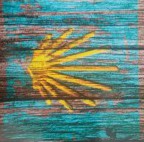After reading a three page sample of my book, my will-be editor suggests removing almost a third of my content. “Less is more,” she says. This again.
On the Camino, they say, your backpack should weigh no more than 10% of your body weight (for me, 11 pounds). Despite this, I started out with a 22 pound pack. After my very first day on the Camino I mailed home almost six pounds of stuff. It was an early lesson in editing, and it was liberating.
So now, when asked to consider getting rid of a whole bunch of words, I will remember that there is a certain freedom in getting by with only what is essential. Less IS more. Keep it light. Shed the excess. It is all, in the end, a lesson in letting go.
For any of you planning to walk a Camino, I thought it may be helpful to have a (well edited) packing list. Here it is:
In a 45L Gregory backpack I packed:
• A pair of collapsible hiking poles with removable rubber tips
• 1.5L platypus (a bag to hold water with a sipping tube)
• A Spork and an airplane-legal camping knife.
• 1/3 roll of toilet paper
• A few of each of the following: Advil, Cold FX, cough drops
• Assorted Band-Aids (regular, butterfly and for blisters)
• Guide book (the non-essential pages torn out)
• Compact head lamp
• Cell phone with charger and European plug converter
• A super small hair dryer (don’t judge me – it came in handy for drying my shoes when they got wet.)
• Toiletries: small toothpaste, tooth brush, tinted powder sunscreen (face), 100ml sunscreen lotion (body), hotel sized shampoo and conditioner, half a bar of soap, travel sized deodorant, nail clippers, dental floss, mascara.
• Safety pins (to pin wet laundry to my backpack) – ESSENTIAL!
• Castil Soap – natural, biodegradable all-purpose soap that worked great for doing laundry by hand
• 1 pair of double layer socks
• 3 pairs of performance quick-dry underwear (expensive but worth it)
• 2 sports bras
• Keen hiking sandals (which carried me the whole 250 kilometers!)
• A pair of foam flip-flops for the hostels
• A ball cap
• 1 ultra-light neck scarf (as sun protection)
• 1 wool Pashmina
• 1 long sleeved performance shirt
• 2 short sleeved performance T-shirts
• 1 fleece with built-in cuff mittens
• 1 waterproof ultra lightweight rain jacket
• ¾ length performance tights
• 1 pair performance shorts (for layering and for sleeping in)
• A tank top for sleeping in
• Zip-off cargo pants (with pockets)
• 1 ‘lounge-wear’ style dress that could be worn both as a night gown and out on the town
• Quick-dry, chamois-style travel towel
• A pillow case
• Light weight sleeping bag
• Security belt that held my passport, 400 Euros, a bank card and a credit card
• Small, flat day-purse
• A written version of my itinerary (this proved to be essential in times of limited internet access)
• A tennis ball. Yes, a tennis ball. A portable massage therapist for tight hips and soles of the feet.
